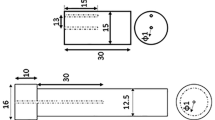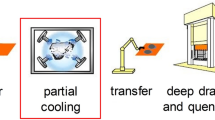Conclusions
-
1.
Choice of working parameters for aqueous polymer solutions depends markedly on the size of the articles being quenched (scale factor). With an increase in article diameter and with constant solution parameters the cooling rate and internal stresses correspond to those achieved with water quenching.
-
2.
For articles with a cross section less than 200 mm quenching in 6.5% CLS solution is similar to oil quenching, and for massive articles it is similar to quenching in 12% CLS solution; with a cylindricals article diameter of more than 500 mm quenching in 12% CLS solution replaces quenching through water into oil.
-
3.
A change in aqueous CLS solution concentration and temperature and use of interrupted quenching makes it possible to fix the level and nature of distribution for residual stresses in articles.
-
4.
Industrial proving and a study of the mechanical properties of medium-carbon steels confirm the efficiency of using aqueous CLS solutions in quenching massive articles made from them.
Similar content being viewed by others
Literature cited
A. V. Tolstousov and O. A. Bannykh, "New quenching media based on water-soluble polymers," Metalloved. Term. Obrab. Met., No. 2, 26–28 (1981).
A. V. Tolstousov and O. A. Bannykh, "Quenching medium based on aqueous polymer solution," Metalloved. Term. Obrab. Met., No. 6, 23–26 (1984).
V. E. Loshkarev, L. E. Mushegyan, and B. L. Paskar', "Study of the level of heat exchange with water and air cooling applied to quenching large rotors," Metalloved. Term. Obrab. Met., No. 6, 2–6 (1989).
E. Burgdorf, "Wissenschaftliche und technologische Aspekte des Abschreckens, Bericht des IVW-Fachausschusses," Härterei-Technische Mitteilungen,36, No. 2, 86–90 (1981).
G. T. Bozhko, O. A. Bannykh, and N. I. Kobasko, "Comparative evaluation of the efficiency of quenching media based on water," Metalloved Term. Obrab. Met., No. 10, 21–25 (1986).
V. E. Loshkarev, "Thermal stresses in quenched steel articles of cylindrical shape with an axial hole," Inzh.-Fiz. Zh.,46, No. 3, 491–498 (1984).
V. E. Loshkarev and É. Yu. Kolpishon, "Use of polymer media for quenching large articles," Metalloved. Term. Obrab. Met., No. 10, 38–40 (1986).
V. E. Loshkarev, "Calculation of quenching stresses taking account of transformation ductility and the effect of stresses on austenite decomposition kinetics," Izv. Vuz. Chern. Metall., No. 1, 111–116 (1988).
Additional information
Central Scientific-Research and Planning Institute for Boilers and Turbines. Bol'shevik Factory. Translated from Metallovedenie i Termicheskaya Obrabotka Metallov, No. 12, pp. 5–10, December, 1990.
Rights and permissions
About this article
Cite this article
Loshkarev, V.E., Sorokina, L.I. & Peskishev, S.A. Use of commercial-grade lignosulfonate solution for quenched large steel articles. Met Sci Heat Treat 32, 896–902 (1990). https://doi.org/10.1007/BF00700077
Issue Date:
DOI: https://doi.org/10.1007/BF00700077




